2004 ISUZU TF SERIES fuse
[x] Cancel search: fusePage 82 of 4264
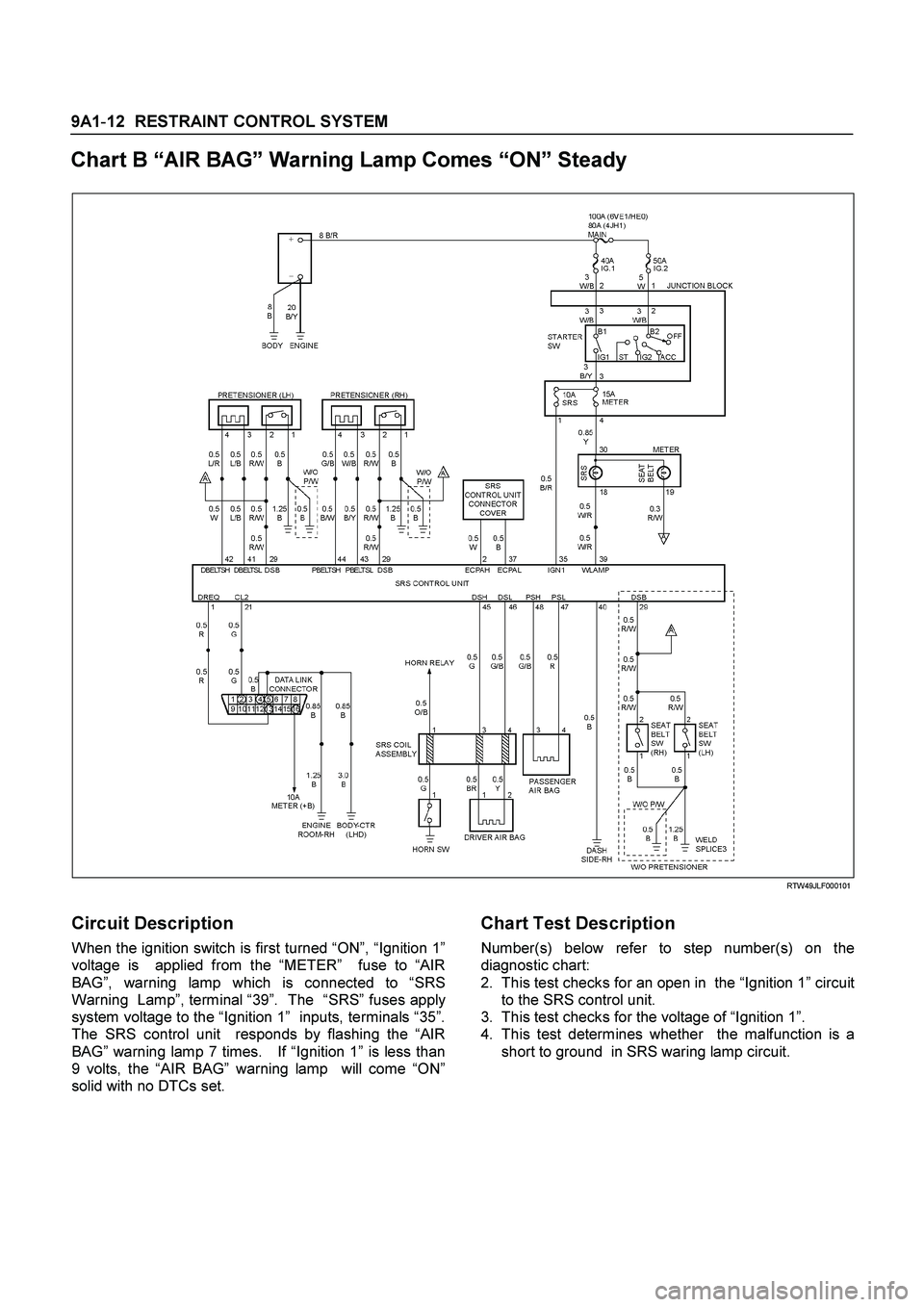
9A1-12 RESTRAINT CONTROL SYSTEM
Chart B “AIR BAG” Warning Lamp Comes “ON” Steady
RTW49JLF000101
Circuit Description
When the ignition switch is first turned “ON”, “Ignition 1”
voltage is applied from the “METER” fuse to “AIR
BAG”, warning lamp which is connected to “SRS
Warning Lamp”, terminal “39”. The “SRS” fuses appl
y
system voltage to the “Ignition 1” inputs, terminals “35”.
The SRS control unit responds by flashing the “AIR
BAG” warning lamp 7 times. If “Ignition 1” is less than
9 volts, the “AIR BAG” warning lamp will come “ON”
solid with no DTCs set.
Chart Test Description
Number(s) below refer to step number(s) on the
diagnostic chart:
2.
This test checks for an open in the “Ignition 1” circuit
to the SRS control unit.
3.
This test checks for the voltage of “Ignition 1”.
4.
This test determines whether the malfunction is a
short to ground in SRS waring lamp circuit.
Page 84 of 4264
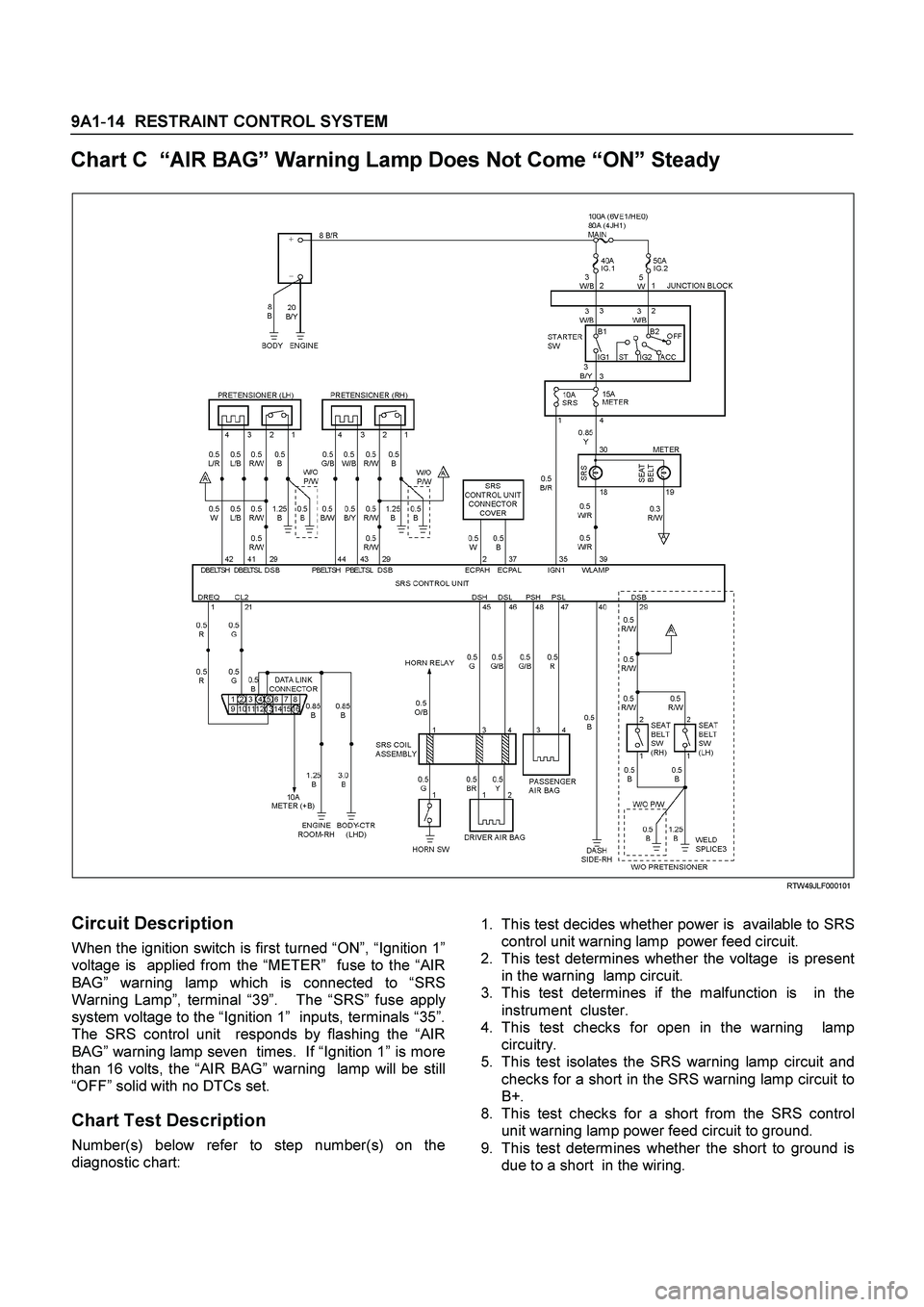
9A1-14 RESTRAINT CONTROL SYSTEM
Chart C “AIR BAG” Warning Lamp Does Not Come “ON” Steady
RTW49JLF000101
Circuit Description
When the ignition switch is first turned “ON”, “Ignition 1”
voltage is applied from the “METER” fuse to the “AIR
BAG” warning lamp which is connected to “SRS
Warning Lamp”, terminal “39”. The “SRS” fuse appl
y
system voltage to the “Ignition 1” inputs, terminals “35”.
The SRS control unit responds by flashing the “AIR
BAG” warning lamp seven times. If “Ignition 1” is more
than 16 volts, the “AIR BAG” warning lamp will be still
“OFF” solid with no DTCs set.
Chart Test Description
Number(s) below refer to step number(s) on the
diagnostic chart:
1.
This test decides whether power is available to SRS
control unit warning lamp power feed circuit.
2.
This test determines whether the voltage is present
in the warning lamp circuit.
3.
This test determines if the malfunction is in the
instrument cluster.
4.
This test checks for open in the warning lamp
circuitry.
5.
This test isolates the SRS warning lamp circuit and
checks for a short in the SRS warning lamp circuit to
B+.
8.
This test checks for a short from the SRS control
unit warning lamp power feed circuit to ground.
9.
This test determines whether the short to ground is
due to a short in the wiring.
Page 85 of 4264
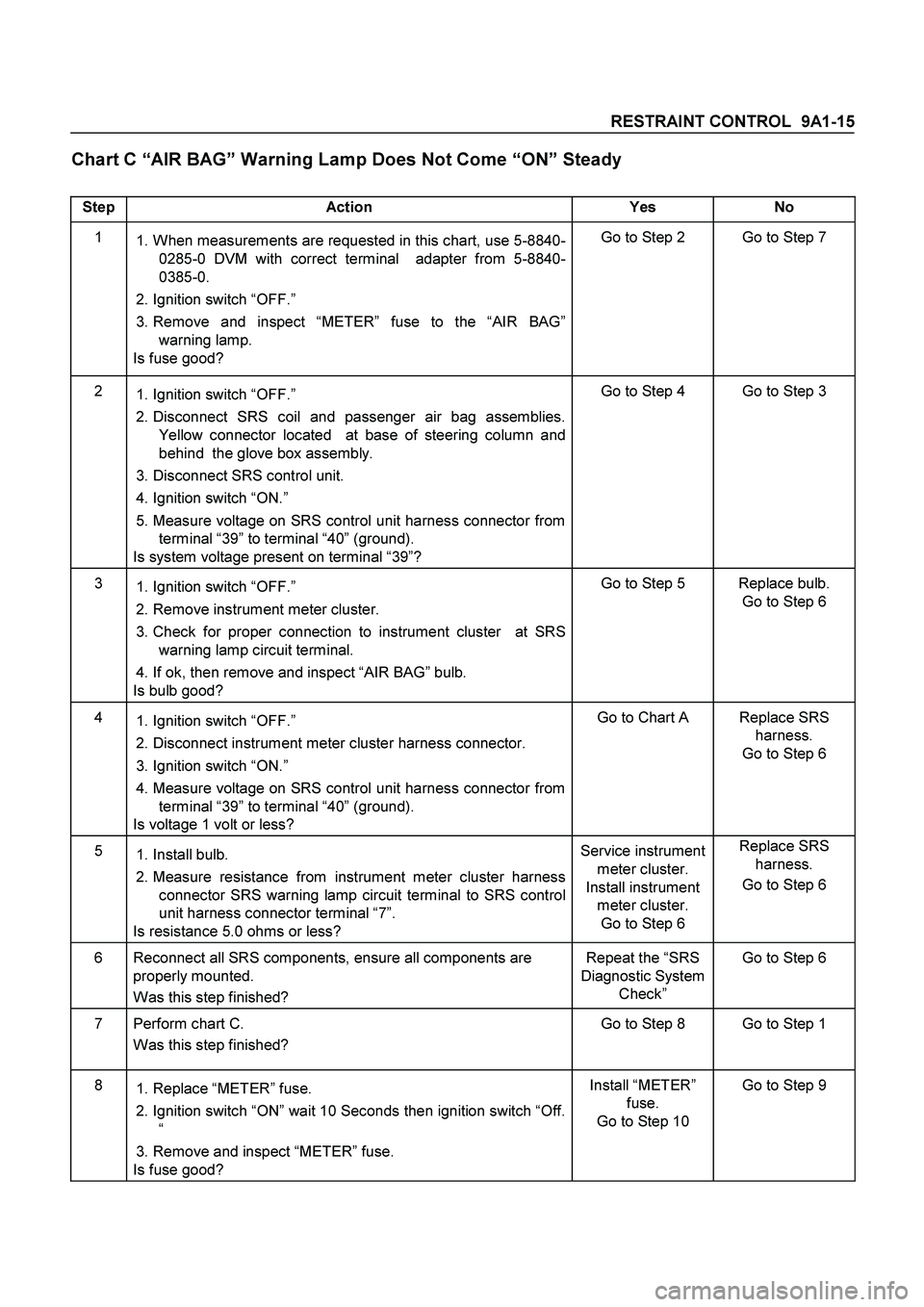
RESTRAINT CONTROL 9A1-15
Chart C “AIR BAG” Warning Lamp Does Not Come “ON” Steady
Step Action Yes No
1
1. When measurements are requested in this chart, use 5-8840-
0285-0 DVM with correct terminal adapter from 5-8840-
0385-0.
2. Ignition switch “OFF.”
3. Remove and inspect “METER” fuse to the “AIR BAG”
warning lamp.
Is fuse good? Go to Step 2 Go to Step 7
2
1. Ignition switch “OFF.”
2. Disconnect SRS coil and passenger air bag assemblies.
Yellow connector located at base of steering column and
behind the glove box assembly.
3. Disconnect SRS control unit.
4. Ignition switch “ON.”
5. Measure voltage on SRS control unit harness connector from
terminal “39” to terminal “40” (ground).
Is system voltage present on terminal “39”? Go to Step 4 Go to Step 3
3
1. Ignition switch “OFF.”
2. Remove instrument meter cluster.
3. Check for proper connection to instrument cluster at SRS
warning lamp circuit terminal.
4. If ok, then remove and inspect “AIR BAG” bulb.
Is bulb good? Go to Step 5 Replace bulb.
Go to Step 6
4
1. Ignition switch “OFF.”
2. Disconnect instrument meter cluster harness connector.
3. Ignition switch “ON.”
4. Measure voltage on SRS control unit harness connector from
terminal “39” to terminal “40” (ground).
Is voltage 1 volt or less? Go to Chart A Replace SRS
harness.
Go to Step 6
5
1. Install bulb.
2. Measure resistance from instrument meter cluster harness
connector SRS warning lamp circuit terminal to SRS control
unit harness connector terminal “7”.
Is resistance 5.0 ohms or less? Service instrument
meter cluster.
Install instrument
meter cluster.
Go to Step 6 Replace SRS
harness.
Go to Step 6
6 Reconnect all SRS components, ensure all components are
properly mounted.
Was this step finished? Repeat the “SRS
Diagnostic System
Check” Go to Step 6
7 Perform chart C.
Was this step finished? Go to Step 8 Go to Step 1
8
1. Replace “METER” fuse.
2. Ignition switch “ON” wait 10 Seconds then ignition switch “Off.
“
3. Remove and inspect “METER” fuse.
Is fuse good? Install “METER”
fuse.
Go to Step 10 Go to Step 9
Page 86 of 4264
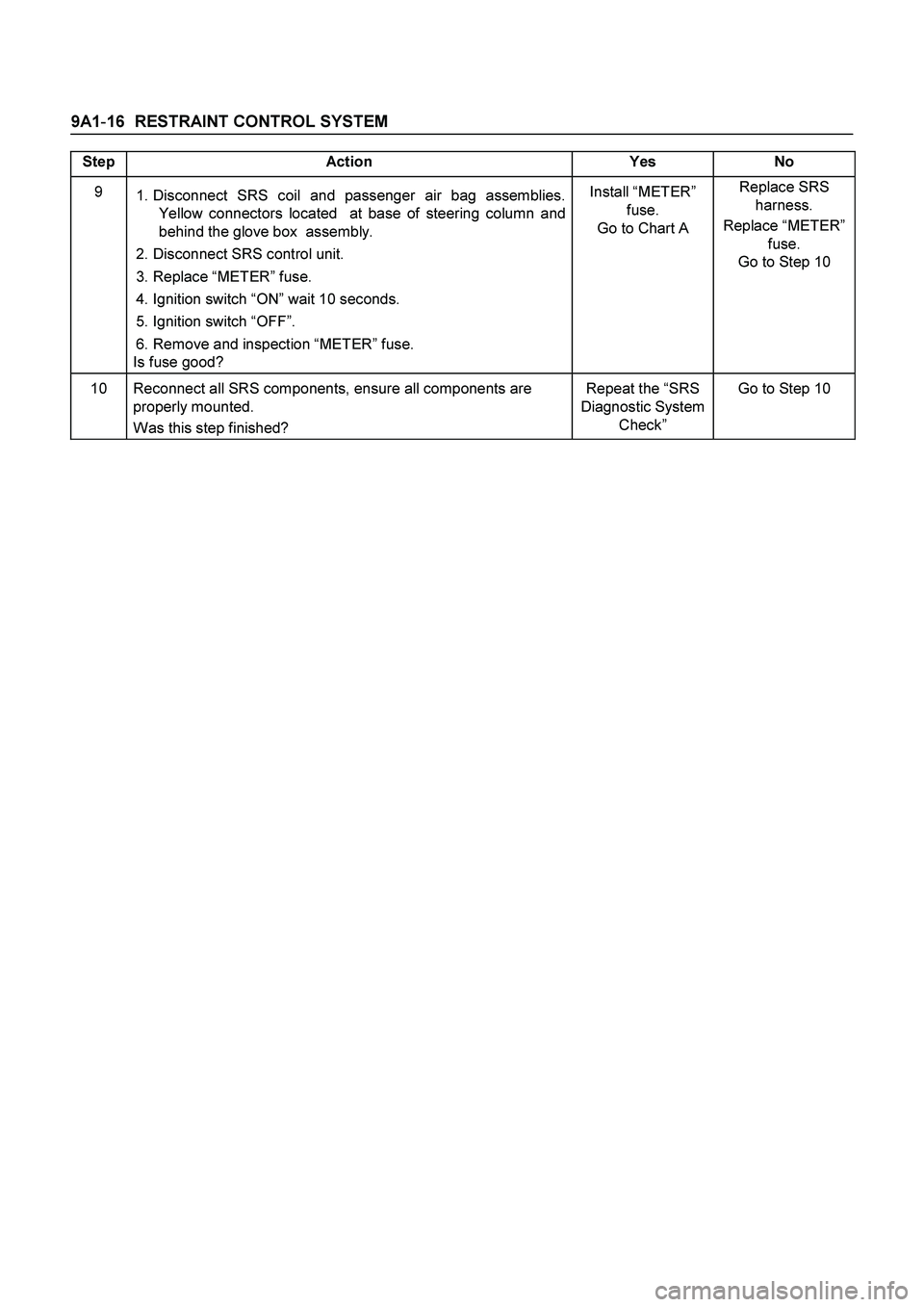
9A1-16 RESTRAINT CONTROL SYSTEM
Step Action Yes No
9
1. Disconnect SRS coil and passenger air bag assemblies.
Yellow connectors located at base of steering column and
behind the glove box assembly.
2. Disconnect SRS control unit.
3. Replace “METER” fuse.
4. Ignition switch “ON” wait 10 seconds.
5. Ignition switch “OFF”.
6. Remove and inspection “METER” fuse.
Is fuse good? Install “METER”
fuse.
Go to Chart A Replace SRS
harness.
Replace “METER”
fuse.
Go to Step 10
10 Reconnect all SRS components, ensure all components are
properly mounted.
Was this step finished? Repeat the “SRS
Diagnostic System
Check” Go to Step 10
Page 330 of 4264
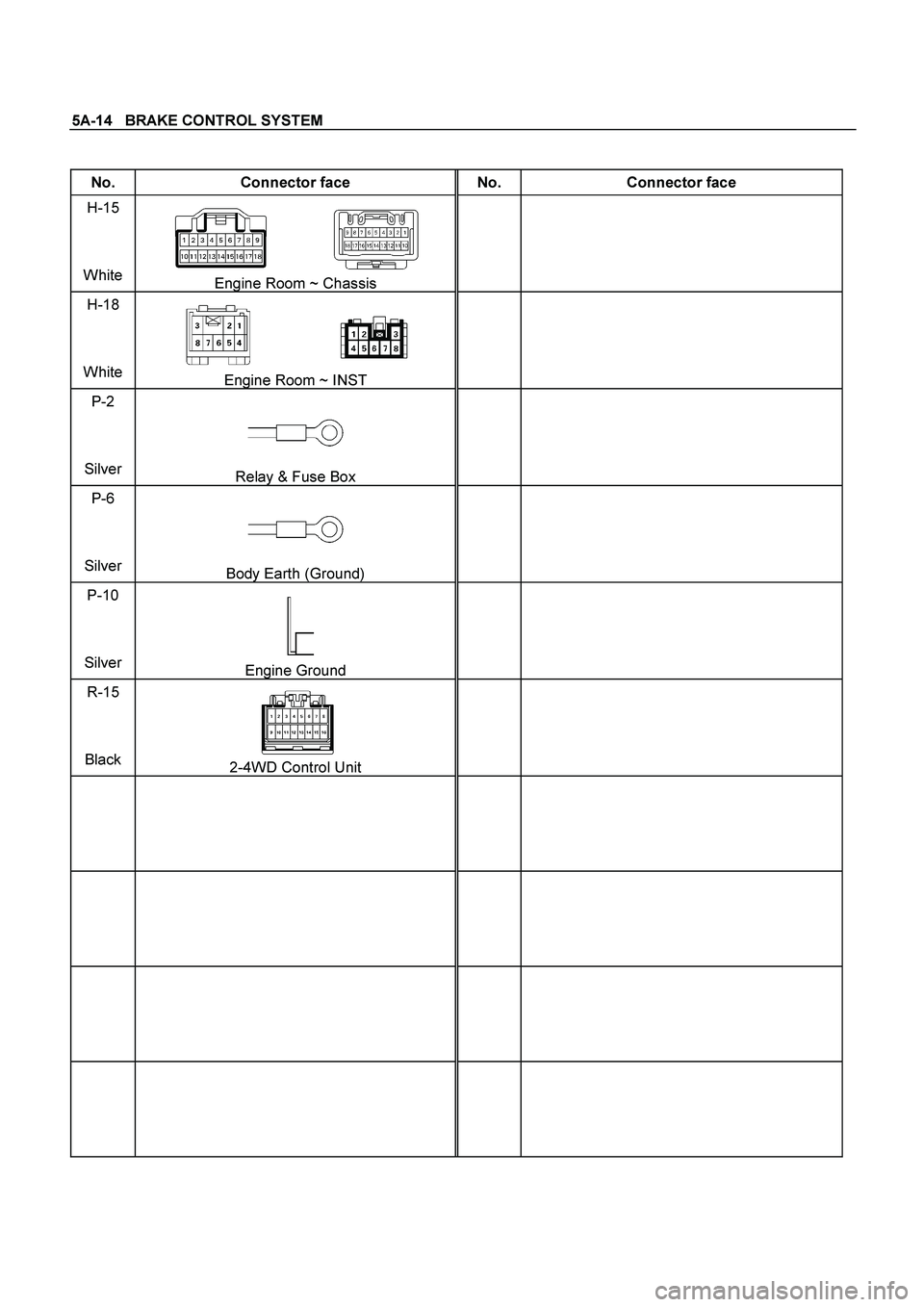
5A-14 BRAKE CONTROL SYSTEM
No. Connector face No. Connector face
H-15
White
Engine Room ~ Chassis
H-18
White
Engine Room ~ INST
P-2
Silver
Relay & Fuse Box
P-6
Silver
Body Earth (Ground)
P-10
Silver
Engine Ground
R-15
Black
2-4WD Control Unit
Page 337 of 4264

BRAKE CONTROL SYSTEM 5A-21
Computer System Service Precautions
The Anti-lock Brake System and Electronic Brake-force
Distribution interfaces directly with the Electronic
Hydraulic Control Unit (EHCU) which is a control
computer that is similar in some regards to the Engine
Control Module. These modules are designed to
withstand normal current draws associated with vehicle
operation. However, care must be taken to avoid
overloading any of the EHCU circuits. In testing for
opens or shorts, do not ground or apply voltage to any
of the circuits unless instructed to do so by the
appropriate diagnostic procedure. These circuits should
only be tested with a high impedance multimeter
5-8840-0366-0 or special tools as described in this
section. Power should never be removed or applied to
any control module with the ignition in the “ON”
position.
Before removing or connecting battery cables, fuses or
connectors, always turn the ignition switch to the “OFF”
position.
General Service Precautions
The following are general precautions which should be
observed when servicing and diagnosing the Anti-lock
Brake System and/or other vehicle systems. Failure to
observe these precautions may result in Anti-lock Brake
System and Electronic Brake-force Distribution
damage.
If welding work is to be performed on the vehicle
using an electric arc welder, the EHCU and valve
block connectors should be disconnected before
the welding operation begins.
The EHCU and valve block connectors should
never be connected or disconnected with the
ignition “ON”.
Note:
If only rear wheels are rotated using jacks or drum
tester, the system will diagnose a speed sensor
malfunction and the “ABS and Brake” warning lamp
will illuminate. But actually no trouble exists. When
the DTC is not detected and the ABS and BRAKE
warning lamp is on, “How to erase code” is
performed and a ABS and BRAKE warning lamp
are off.
If the battery has been discharged
The engine may stall if the battery has been completely
discharged and the engine is started via jumper cables.
This is because the Anti-lock Brake System (ABS) and
Electronic Brake-force Distribution (EBD) System
requires a large quantity of electricity. In this case, wait
until the battery is recharged, or set the ABS and EBD
to a non-operative state by removing the fuse for the
ABS. After the battery has been recharged, stop the
engine and install the ABS fuse. Start the engine again,
and confirm that the ABS warning Lamp does not light.
Note on Intermittents
As with virtually any electronic system, it is difficult to
identify an intermittent failure. In such a case
duplicating the system malfunction during a test drive or
a good description of vehicle behavior from the
customer may be helpful in locating a “most likely”
failed component or circuit. The symptom diagnosis
chart may also be useful in isolating the failure. Most
intermittent problems are caused by faulty electrical
connections or wiring. When an intermittent failure is
encountered, check suspect circuits for:
Suspected harness damage.
Poor mating of connector halves or terminals not
fully seated in the connector body (backed out).
Improperly formed or damaged terminals.
Test Driving ABS Complaint Vehicles
In case that there has been an abnormality in the
lighting pattern of “ABS” warning lamp, the fault can be
located in accordance with the “DIAGNOSIS BY “ABS”
WARNING LAMP ILLUMINATION PATTERN”. In case
of such trouble as can be detected by the driver as a
vehicle symptom, however, it is necessary to give a test
drive following the test procedure mentioned below,
thereby reproducing the symptom for trouble diagnosis
on a symptom basis:
1.
Start the engine and make sure that the “ABS” W/L
goes OFF. If the W/L remains ON, it means that
the Diagnostic Trouble Code (DTC) is stored.
Therefore, read the code and locate the fault.
Note: The DTC cannot be cleared if the vehicle speed
does not exceed about 6km/h (4mph) at DTC, even
though the repair operation is completed.
2. Start the vehicle and accelerate to about 30 km/h
(19 mph) or more.
3. Slowly brake and stop the vehicle completely.
4. Then restart the vehicle and accelerate to about 40
km/h (25 mph) or more.
5. Brake at a time so as to actuate the ABS and stop
the vehicle.
6. Be cautious of abnormality during the test. If the
W/L is actuated while driving, read the DTC and
locate the fault.
7. If the abnormality is not reproduced by the test,
make best efforts to reproduce the situation
reported by the customer.
8. If the abnormality has been detected, repair in
accordance with the “SYMPTOM DIAGNOSIS” .
Note:
Be sure to give a test drive on a wide, even road
with a small traffic.
If an abnormality is detected, be sure to suspend
the test and start trouble diagnosis at once.
Page 357 of 4264

BRAKE CONTROL SYSTEM 5A-41
Brake Pedal Feed Is Abnormal
Step Action
Value(s) Yes No
1 Is the stop light actuated when the brake pedal is
depressed?
- Go to Step 2 Go to Step 3
2 1. Turn the ignition switch off.
2. Disconnected EHCU connector.
Is the check voltage for EHCU connector terminals
when brake pedal is depressed than battery voltage?
- Go to Step 4 Harness NG
between stop
light SW and
EHCU.
Go to Step 6
3 Is stop light fuse normal?
- Go to Step 5 Replace stop
light fuse.
Go to Step 6
4 Is the check continuity between EHCU connector to
body grounded?
- Go to Step 6 Repair body
grounded
harness.
Go to Step 6
5 Is stop light switch operation normal?
- Repair stop
light harness.
Go to Step 6 Replace stop
light switch.
Go to Step 6
6 Reconnect all components, ensure all components
are properly mounted.
Was this step finished?
- Repeat the
“Basic
diagnostic
flow chart” Go to Step 6
Page 359 of 4264

BRAKE CONTROL SYSTEM 5A-43
No ABS Warning Lamp
Step Action
Value(s) Yes No
1 Check the meter fuse for the instrument cluster
ignition feed circuit.
Is the fuse OK? - Go to Step 3 Go to Step 2
2 Replace the fuse.
Is the action complete? - Verify repair
Go to Step 3 -
3 1. Ignition “OFF,” disconnect the EHCU.
2. Ignition “ON,”engine “OFF.”
3. Observe the ABS warning lamp.
Is the ABS warning lamp “ON”?
- Go to Step 5 Go to Step 4
4 Repair or replace the meter circuit or meter.
Is the action complete? - Verify repair -
5 1. Check the EHCU circuit for an open, short to
ground, or short to voltage. Also, check the EHCU
ignition feed circuit for an open or short to ground
and the EHCU ground circuit for an open.
2. If a problem is found, repair as necessary.
Was a problem found?
- Verify repair Go to Step 6
6 1. Ignition “OFF,” reconnect the EHCU.
2. Ignition “ON,”engine “OFF.”
3. Observe the ABS warning lamp.
Is the ABS warning lamp “ON”?
- Verify repair Go to Step 7
7 Replace EHCU.
Note : Check the EHCU type for specification, the
EHCU is replaced.
(Specification; 2WD or 4WD Model)
Is the action complete? - Verify repair -